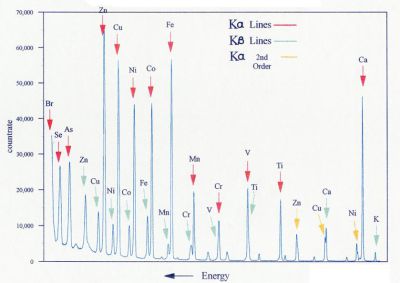Difference between revisions of "PXRF"
Jump to navigation
Jump to search
| Line 4: | Line 4: | ||
The technique of x-ray fluorescence (XRF) is outlined nicely on [https://en.wikipedia.org/wiki/X-ray_fluorescence Wikipedia]. The fundamentals are, you use high energy x-rays to eject core electrons from an element and when electrons in higher orbitals drop in to fill these once occupied orbitals, they emit/fluoresce lower energy x-rays which are then detected. The emission chart below is taken from Wikipedia and showns the emission frequencies for many element. | The technique of x-ray fluorescence (XRF) is outlined nicely on [https://en.wikipedia.org/wiki/X-ray_fluorescence Wikipedia]. The fundamentals are, you use high energy x-rays to eject core electrons from an element and when electrons in higher orbitals drop in to fill these once occupied orbitals, they emit/fluoresce lower energy x-rays which are then detected. The emission chart below is taken from Wikipedia and showns the emission frequencies for many element. | ||
| − | [[File:XRFScan.jpg|thumb|none]] | + | [[File:XRFScan.jpg|thumb|400px|none]] |
Revision as of 23:02, 13 January 2022
Monmouth College acquired a portable X-ray Fluorescence (pXRF) spectrometer thru a combination of LeSuer funding (~$20K) and a PittConn Grant (~$10K). The grant proposal can be found here.
Introduction
The technique of x-ray fluorescence (XRF) is outlined nicely on Wikipedia. The fundamentals are, you use high energy x-rays to eject core electrons from an element and when electrons in higher orbitals drop in to fill these once occupied orbitals, they emit/fluoresce lower energy x-rays which are then detected. The emission chart below is taken from Wikipedia and showns the emission frequencies for many element.
